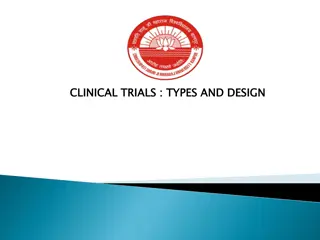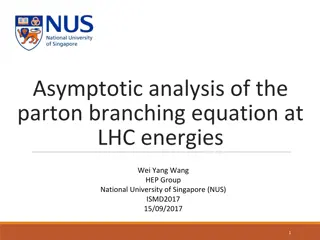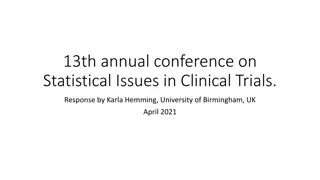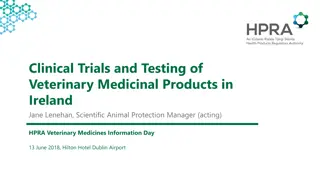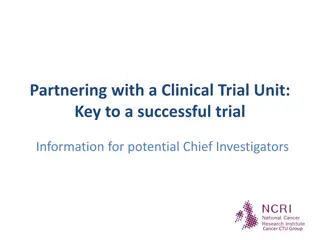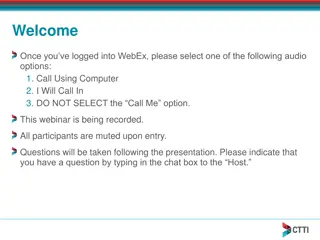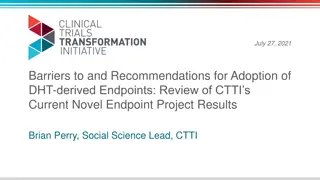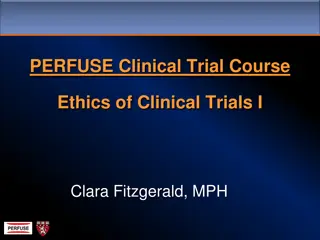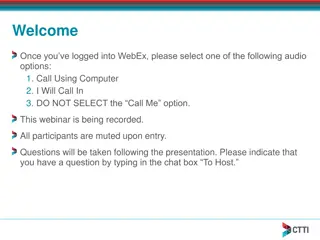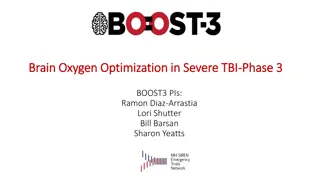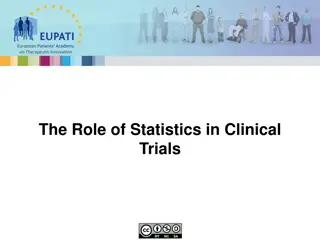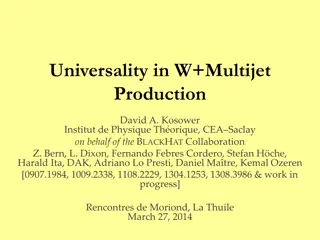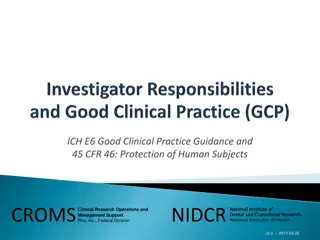Multiplicity Adjustment in Clinical Trials: Methods and Applications
Explore the importance of multiplicity adjustment methods in the design and analysis of clinical trials, including the motivation behind classical approaches, examples of multiplicity problems, and the concept of controlling Familywise Error Rate (FWER). Understand the need for adjusting p-values to maintain statistical rigor and validity in medical research.
- Clinical Trials
- Multiplicity Adjustment
- Familywise Error Rate
- Statistical Analysis
- Hypothesis Testing
Download Presentation

Please find below an Image/Link to download the presentation.
The content on the website is provided AS IS for your information and personal use only. It may not be sold, licensed, or shared on other websites without obtaining consent from the author. Download presentation by click this link. If you encounter any issues during the download, it is possible that the publisher has removed the file from their server.
E N D
Presentation Transcript
MULTIPLICITY ADJUSTMENT IN DESIGN AND ANALYSIS OF CLINICAL TRIALS Daniel Zhao Presidential Professor Associate Dean for Research Hudson College of Public Health University of Oklahoma Health Sciences Center 8/13/2021
Outline Motivate using classical multiplicity adjustment methods (multiple comparison, multiple testing) Examples of multiplicity problems Define Familywise Error Rate (FWER) Why is the controlling of FWER necessary Weak and strong control of FWER Closed Testing Principle for controlling FWER Adjusted p-values Common multiplicity adjustment procedures 2
Motivation (1) Single continuous outcome y, at single time point Treatment with multiple groups (1, 2, 3). Active treatments: 1, 2 Control: 3 Pairwise comparisons (1 vs 2, 1 vs 3, 2 vs 3) Bonferroni Adjustment (nonparametric) Tukey Adjustment (parametric) SAS code (adjusted p-values): proc glm; class treatment; model y=treatment; lsmeans treatment/adjust=bon pdiff; lsmeans treatment/adjust=tukey pdiff; 3
Motivation (2) Active vs control (1 vs 3, 2 vs 3) Rationale: increase power (smaller p-value) with a smaller number of comparisons Bonferroni Adjustment Dunnett Adjustment SAS code: lsmeans treatment/adjust=dunnett pdiff=control( 3 ); SAS outputs adjusted p-values which should be compared to 2-sided .05 level SAS demo 4
Examples of multiplicity problems Multiple treatment comparisons Dose-response studies Multiple primary endpoints the efficacy profile of cardiovascular drugs is typically evaluated using multiple outcome variables such as all-cause mortality, nonfatal myocardial infarction, or refractory angina/urgent revascularization Multiple secondary endpoints. progression-free survival and overall survival Multiple patient populations Overall population and Subgroup defined by a signature Multiple looks Group sequential and Adaptive design 5
Familywise Error Rate (FWER) Consider ? null hypotheses: ?1, ,??, each is tested using one test statistic and a p-values is calculated. Eg, log-rank for ?1, t-test for ?2, chi-squared for ?3, etc. FWER = ?(reject at least one of ?1, ,??|?1, ,?? all are true), if only the first ? hypotheses are true. A wrong practice without considering FWER control Consider a randomized controlled clinical trial comparing drug vs control. Two hypothesis testing were performed with two p-values Raw Log-rank p-value for overall survival is ?1= .04 < .05. (Survival curves are separated and in favor of drug). Raw Two-sample t-test p-value for quality of life is ?2= .03 < .05. (in favor of drug). (Wrong) Conclusion: Drug significantly prolongs life and improves quality of life 6
What happens if FWER is not controlled? Let s assume the ? test statistics for ?1, ,?? are independent each of the hypothesis is tested at .05 level FWER = 1 ?(accept all of ?1, ,??|?1, ,?? all are true) =1 i?(accept ??|?? is true) = 1 0.95? FWER = 33.7% when k= 8 FWER = 64.2% when k= 20 7
Weak and Strong Control of FWER Consider ? null hypotheses: ?1, ,?? A multiplicity adjustment procedure (MAP) is said to control FWER in the weak sense if it controls the FWER under the global null configuration (intersection of all null hypotheses, ???), but not necessarily under all other configurations An MAP is said to control FWER in the strong sense if it controls the FWER under all possible null configurations Example of all possible null configurations when ? = 3 All 3-way intersections: ?1 ?2 ?3 All 2-way intersections: ?1 ?2,?1 ?3,?2 ?3 All individual null hypotheses: ?1,?2,?3 Strong control implies weak control, and we want MAPs strongly control FWER 8
Closed Testing Principle (1) Consider ? null hypotheses: ?1, ,?? We can construct MAPs based on definition of strong control of FWER, which can be hard Another way is to use Closed Testing Principle Test every member (configuration) of the closed family by a ?-level test Reject an individual hypothesis (?1, ,??) if its corresponding ?-level test rejects it, and every interaction hypothesis includes it is also rejected An example (next slide), Reject ?2 if the following hypotheses are rejected at ?-level ?2 ?1 ?2,?2 ?3,?2 ?4, ?1 ?2 ?3,?1 ?2 ?4,?2 ?3 ?4 ?1 ?2 ?3 ?4 9
Adjusted p-values Example two hypotheses ?1 and ?2 FWER controlled at .05 ? level Bonferroni adjustment with equal split of ? One way is to compute raw p-values ?1 for ?1 and ?2 for ?2, claim significance if either of the p-values is less than .05/2=.025 Another way is to compute adjusted p-values ?1= 2?1, ?2= 2?2, still compare ?1 and ?2with .05 In general, adjusted p-value for any hypothesis is the smallest nominal ? level at which that hypothesis would be rejected. In other words, it is inverse of the ? spending function. 11
Multiplicity Adjustment Procedures For illustration, we begin with 4 p-values (? = 4)for testing ?1t0?4 ?1= 0.01,?2= 0.03,?3= 0.20,?4= 0.52 The 4 p-values may be obtained from running 4 t-tests on four outcome variables comparing drug vs control Goal is to know whether any of the 4 p-values are significant at FWER .05 level Many MAPs are developed Single Step: Bonferroni, Sidak, Simes Stepwise: Holm, Hormel, Hochberg Prespecified ordering: fixed sequence, gatekeeping, fallback Chain 12
Bonferroni Procedure Single-step, nonparametric (works for any joint distribution of p-values), strongly control FWER Reject ?? if ??<? ? Adjust p-values ??= ??? if ???< 1;= 1, otherwise. For our example, ?1= 0.04, ?2= 0.12, ?3= 0.80, ?4= 1.00 13
Sidak Procedure Single-step, Semiparametric (if the ? test statistics are either independent, or follow a multivariate normal distribution, or follow a multivariate t distribution). ? Adjust p-values ??= 1 1 ?? For our example, ?1= 0.04, ?2= 0.11, ?3= 0.59, ?4= 0.95 Sidak is more powerful than Bonferroni Both Bonferroni and Sidak are very conservative (produce larger adjusted p-values than other procedures) 14
Simes Procedure Single-step, Semiparametric (if the ? test statistics are either independent, or follow a multivariate normal distribution with non-negative correlations). Can only be used to test the global null hypothesis ?1 ?2 ?? Simes procedure Let ?(1) ?2 ?? be ordered p-values Reject global null if ?(?) ??/? for at least one ? ?(1) 1, ?(2) 2, , ?(?) ?) Adjusted p-value: ? = ?min( 15
Bonferroni-Holm (Holm) Procedure Step-down, nonparametric, based on Bonferroni Let ?(1) ?2 ?? be ordered p-values and ?(1),?(2), ,?(?) be the corresponding hypotheses. Step 1. Compare ?(1) with ?/?. If larger, stop and accept all hypotheses; otherwise, reject ?(1) and proceed. Step 2. Compare ?(2) with ?/(? 1). If larger, stop and accept ?(2), ,?(?); otherwise, reject ?(2) and proceed. Step k. Compare ?(k) with ?. If larger, stop and accept ?(?); otherwise, reject ?(?) Adjusted p-value: ?(?)= min(1,max ? ?[ ? ? + 1 ?(?)] SAS output labels this as Stepdown Bonferroni 16
Simes-Hormel (Hormel) Procedure Step-up, semiparametric (same assumption as the Simes) Let ?(1) ?2 ??be ordered p-values and ?(1),?(2), ,?(?)be the corresponding hypotheses. Step 1. If ?(?)> ?, accept ?(?) and move to next step. Otherwise, stop and reject all the hypotheses. Step ? = 2, ,? 1, If ?(? ?+?)> ??/? for all ? = 1, ?, accept ?(? ?+1) and move to next step. Otherwise, stop and reject all remaining hypotheses. Step ?. If ?(?)> ??/? for all ?, or ?(1)> ?/(? 1), accept ?(1). Otherwise, reject ?(1). 17
Hochberg Procedure Step-up, semiparametric (same assumption as the Hormel) Hormel s procedure is hard to explain to investigators. Hochberg is a simplified Hormel but uniformly less powerful. Let ?(1) ?2 ??be ordered p-values and ?(1),?(2), ,?(?)be the corresponding hypotheses. Step 1. If ?(?)> ?, accept ?(?) and move to next step. Otherwise, stop and reject all the hypotheses. Step ? = 2, ,? 1, If ?(? ?+1)> ?/?, accept ?(? ?+1) and move to next step. Otherwise, stop and reject all remaining hypotheses. Step ?. Reject ?(1) if ?(1) ?/? . 18
Fixed-sequence procedure Suppose that there is a natural ordering among the null hypotheses ?1, ,?? The order in which the testing is performed is fixed. This order normally reflects the clinical importance of the multiple analyses. Eg, test the primary analysis first, then the most important secondary analysis, etc Can also be used to test the onset of therapeutic effect of say, Cialis. Step 1: Reject ?1 if ?1< .05 and move to test ?2. OW, stop and accept all the hypotheses. Step 2: repeat the process for remaining hypotheses Adjusted p-values: ?1= ?1, ?2= max ?1,?2, etc Examples: 1. 2. ?1= .06,?2= .02 ?1= .04,?2= .02 20
Gatekeeping A slight variation on fixed sequence procedure Used when there is one test of primary importance (?1), and (? 1) other tests of less importance (?2, ??). Step 1: If ?1 .05, stop and accept all hypotheses; OW, declare significance for ?1 and move on to Step 2 Step 2: Test ?2, ?? at FWER .05 level still. Benefits: No need to adjust the primary test for multiplicity at all 1 less number of hypotheses for the secondaries Drawbacks (similar to fixed-sequence): If the primary is insignificant, even with ?1= .051, then you must give up any significance on ay secondary, even one with ? = .000001 21
Fallback Procedure Similar to fixed sequence and gatekeeping, null hypotheses ?1, ,?? are ordered. Allocate the FWER ? = 0.05 to all the null hypotheses using weights ?1, ,?? The idea is to recycle ? if not used by previous testing Step 1: If ?1< ?1= ?1?, reject ?1; OW, accept ?1 and move on to next step. Step 2: Test ?2 at ?2= ?2? if ?1 is accepted, and at ?2= ?1+ ?2? if ?1 is rejected. If ?2< ?2, reject ?2; OW, accept ?2and move on to next step. Repeat until Step ? Examples: FWER ? = .05, two hypotheses ?1 and ?2. ?1= ?2= .5 1. ?1= .03,?2= .04 2. ?1= .01,?2= .04 22
Chain Procedure The class of nonparametric procedures known as chain procedures provides an extension of the fixed-sequence and fallback procedures It pre-assign weights, like fallback procedures. It supports propagation rules, e.g., after each rejection, the error rate can be transferred simultaneously to several hypotheses. Example A hypertension dose finding clinical trial with Placebo, Low, Medium, and High dose of a study drug. Data available from the Phase II trial suggest that the H>M, H>L, but M=L. The fixed-sequence and fallback procedures might be suboptimal because there is no clear hierarchical testing order between the L and M doses. So, a chain procedure is developed 23
Chain Procedure Example (1) Three hypotheses (vs placebo): ??,??,?? Initial hypothesis weights: ??=1 3 hypotheses are ? 2,??= ??=1 4. So the initial significance levels for the 2,? 4,? 4 Transition parameters ???,???,???,??? determine how ? is propagated in case a hypothesis is rejected. The arrows indicate the direction of propagations. The error rate released after the rejection of ?? is split between ?? and ??. If ?? is rejected, all the error rate is transferred to ??, vice versa. 24
Chain Procedure Example (2) Assume we observed 3 raw p-values ??= 0.017,??= 0.026,??= 0.022 Begin with ?? Because ??< .05/2, reject ??. And its error rate (.05/2) can now be equally split between ?? and ?? So, now, the significance level for ?? is .05/4 (initial assignment) plus .05/4 , =.025 Similarly, the significance level for ?? is also .025 For ??, Because ??> .025, we fail to reject ?? (for now) and no further ? can be transferred to ?? For ??, Because ??< .025, we reject ?? and transfer its .025 to ??, which now can be tested at .025 + .025 = .05 level (Surprise!) Since ??< .05, we reject ?? also. Conclusion: We rejected all 3 hypotheses while controlling FWER. 25



